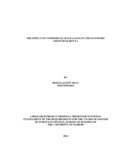| dc.description.abstract | The Basel Committee on Banking Supervision noted the influence of loans on economic
growth by asserting that that the monetary policy affects the supply of bank credit and
banks, being the players in the credit market, contribute to the transformation of the
monetary policy into macroeconomic outputs in the economy. One of the macroeconomic
outputs is economic growth. This research, therefore, sought to determine the effect of
commercial bank loans on Kenya's economic growth.
The research was time series correlation study. Economic growth, the dependent variable,
was correlated with the annual rates of changes in lending by commercial banks as
proxied by the financing arrangements by commercial banks. The data on economic
growth were obtained from the Kenya National Bureau while the data on loans were
collected from the audited financial statements of the 43 commercial banks in Kenya. The
data used covered the period 2008 to 2012 and covered all the 43 commercial banks.
Economic growth was regressed against rates of change in amounts lent by commercial
banks lagged one year.
The findings show that, first; the distribution of economic growth rate was not normally
distributed, but skewed towards the right. Secondly, the distribution of the rate of change
in the amounts of loans issued to borrowers was normally distributed. Thirdly, the
correlation between economic growth rate and the rate of change in the amounts of loans
issued was -0.097 as measured by the Pearson's Correlation Coefficient. This indicates
that a positive change in amounts of loans issued was matched with a slight drop in
economic growth. In the regression analysis, the constant term was 5.98074 which was
statistically insignificantly different from zero as indicated by a p-value of 0.3066. The
coefficient of the rate of change in the amounts of loans was -0.0372122 and statistically
insignificant as indicated by a p-value of 0.7971. The whole regression was statistically
insignificant as shown by F (1, 1)=0.108844 (p>0.05). The research concludes that
economic growth in Kenya is not driven by changes in lending. This is an indication that
Kenya's economic growth is not strongly determined by the loans issued by banks to
private borrowers. This research, therefore, recommends the use of driving forces, other
than commercial bank loans to push economic growth. | en_US |

